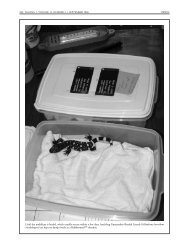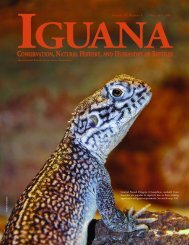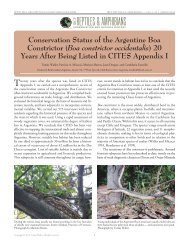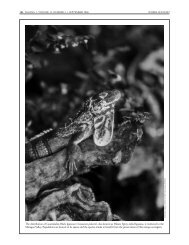Spiny-tailed Iguanas (Ctenosaura similis) in Venezuela
Spiny-tailed Iguanas (Ctenosaura similis) in Venezuela
Spiny-tailed Iguanas (Ctenosaura similis) in Venezuela
You also want an ePaper? Increase the reach of your titles
YUMPU automatically turns print PDFs into web optimized ePapers that Google loves.
176 IGUANA • VOLUME 15, NUMBER 3 • SEPTEMBER 2008 COMMENTARIES<br />
Toward the back of the hall, a dated “high tech” video <strong>in</strong>stallation<br />
<strong>in</strong>serts kids <strong>in</strong>to a picture with d<strong>in</strong>osaurs <strong>in</strong> it, as if they<br />
were starr<strong>in</strong>g <strong>in</strong> Jurassic Park, a movie that today’s children are<br />
no more likely to have seen than the old TV show, Land of the<br />
Lost. The kids make ugly faces and dance while watch<strong>in</strong>g themselves<br />
on screen until the next group comes <strong>in</strong> and shoves them<br />
out.<br />
Never m<strong>in</strong>d that D<strong>in</strong>osaur Hall was one of the most<br />
important sites <strong>in</strong> the <strong>in</strong>stitutional history of paleontology.<br />
Discovered <strong>in</strong> 1858, the academy’s Hadrosaurus was the first<br />
mounted d<strong>in</strong>osaur skeleton <strong>in</strong> the world. D<strong>in</strong>omania started <strong>in</strong><br />
Philadelphia. Now the tower<strong>in</strong>g Hadrosaurus is hunched over —<br />
<strong>in</strong> deference to current theory — and banished to an <strong>in</strong>conspicuous<br />
corner to make room for a gather<strong>in</strong>g of fossil replicas<br />
designed as photo-ops. Instead of gaz<strong>in</strong>g up at a relic of the<br />
heroic era of Victorian science, people ignore the Hadrosaurus<br />
and get their picture taken with their head beneath the jaws of<br />
the scary Giganotosaurus, a sort of Tyrannosaurus rex on steroids,<br />
before go<strong>in</strong>g to the gift shop to buy a “sharp toothed” plush toy.<br />
See, kids, science can be fun!<br />
But programmed “fun” is not necessarily pleasure, nor is<br />
enterta<strong>in</strong>ment the only means of spark<strong>in</strong>g an <strong>in</strong>terest <strong>in</strong> science.<br />
The people who run museums these days seem to th<strong>in</strong>k that<br />
children cannot enjoy quiet reflection. I suppose they th<strong>in</strong>k that<br />
would be elitist. As a result, decorum — once one of the key lessons<br />
of the museum for children — is replaced by the rules of<br />
the schoolyard, the serious is usurped by the cute, and thought<br />
is banished by the chatter of last decade’s high-tech gizmos.<br />
In Stuffed Animals & Pickled Heads: The Culture and<br />
Evolution of Natural History Museums (Oxford, 2001), Stephen<br />
T. Asma quoted one curator from the Field Museum <strong>in</strong><br />
Chicago: “The sad fact is that many quieter people, who put <strong>in</strong><br />
years of good work at the Field Museum, have recently lost their<br />
jobs to more dynamic but less educated competitors. The nature<br />
of the work, hunched over t<strong>in</strong>y bugs or fossils <strong>in</strong> a hidden-away<br />
cubicle, for example, traditionally drew <strong>in</strong>troverts to the curator<br />
and staff jobs. And the museum nurtured them.” Instead, the<br />
curator laments that “the current trend is for museum trustees<br />
and adm<strong>in</strong>istrators to ignore the <strong>in</strong>ternal, albeit quirky, talent<br />
when staff<strong>in</strong>g positions of power and go outside for M.B.A.’s<br />
who frequently don’t know anyth<strong>in</strong>g about the nuances of the<br />
subject matter.”<br />
Fortunately, it is still possible <strong>in</strong> some of the larger museums<br />
and the more obscure ones to f<strong>in</strong>d older exhibits — silent<br />
corridors of glass cases filled with specimens — that have not<br />
been ru<strong>in</strong>ed by the addition of push-button TV sets, cuddly<br />
mascots, and other contemporary affectations. In particular, I<br />
enjoy the animal dioramas created from the 1920s through the<br />
1940s. Those are not mere scientific displays; they are among<br />
the most <strong>in</strong>terest<strong>in</strong>g and underrated art works of the 20 th century.<br />
Some of them are the three-dimensional equivalents of<br />
Audubon’s Birds of America. Successful museum <strong>in</strong>stallations<br />
need not always require huge expenditures for blockbuster<br />
attractions like the Field Museum’s $8-million T-rex, “Sue,” the<br />
most expensive fossil <strong>in</strong> the world (the conspicuous cost be<strong>in</strong>g<br />
the real attraction).<br />
I remember that the second-best th<strong>in</strong>g about the Academy<br />
of Natural Sciences, back <strong>in</strong> the 70s, was someth<strong>in</strong>g called the<br />
“Trad<strong>in</strong>g Post.” It was a large display counter full of rocks, fossils,<br />
and bones. Kids could br<strong>in</strong>g <strong>in</strong> specimens from their own<br />
collections and trade them for someth<strong>in</strong>g new. I once brought<br />
<strong>in</strong> a box of ord<strong>in</strong>ary seashells from the Jersey shore and<br />
exchanged them for two skulls: a cat and a rabbit, as I recall. The<br />
Trad<strong>in</strong>g Post always gave kids the better end of the barga<strong>in</strong>, and<br />
it kept me explor<strong>in</strong>g the creeks and vacant lots <strong>in</strong> my neighborhood,<br />
discover<strong>in</strong>g that nature even existed <strong>in</strong>side the city. (Those<br />
specimens are still <strong>in</strong> my cab<strong>in</strong>ets, and my daughters are start<strong>in</strong>g<br />
to add their own f<strong>in</strong>d<strong>in</strong>gs to the collection.)<br />
There are also a few museums that have been preserved by<br />
benign neglect, such as the Wagner Free Institute of Science, also<br />
<strong>in</strong> Philadelphia, and the Harvard Museum of Natural History.<br />
And, I th<strong>in</strong>k, foremost <strong>in</strong> the United States, the American<br />
Museum of Natural History <strong>in</strong> New York has preserved,<br />
expanded, and updated itself without sacrific<strong>in</strong>g too much of its<br />
history and grandeur.<br />
In the American Museum, for example, the curators took<br />
the risk of hav<strong>in</strong>g their enormous Barosaurus rear up, with its<br />
head 50 feet <strong>in</strong> the air, defend<strong>in</strong>g its young from an advanc<strong>in</strong>g<br />
Allosaurus. Set amid the marble columns of Roosevelt Memorial<br />
Hall, the display is awe-<strong>in</strong>spir<strong>in</strong>g, perhaps the greatest mounted<br />
d<strong>in</strong>osaur <strong>in</strong> the world. The museum’s Barosaurus is probably bad<br />
science, but it is also an important work of public art that<br />
expresses the obligations of one generation to another <strong>in</strong> a<br />
medium that a child can appreciate as well as an adult.<br />
Natural-history museums are not just about science. Why<br />
couldn’t the academy <strong>in</strong> Philadelphia leave D<strong>in</strong>osaur Hall alone?<br />
Were the memories associated with that sett<strong>in</strong>g not worth anyth<strong>in</strong>g<br />
to the curators? No doubt for the hard pressed natural-history<br />
museum, an alliance between science and bus<strong>in</strong>ess — i.e.,<br />
enterta<strong>in</strong>ment, tourism, and merchandis<strong>in</strong>g — seems more susta<strong>in</strong>able<br />
than the old l<strong>in</strong>kage between science and the humanities<br />
— i.e., art, history, and even religion, and their comb<strong>in</strong>ed<br />
power to cultivate wonder and imag<strong>in</strong>ation.<br />
On the other hand, I do admire the efforts of many natural-history<br />
museums — <strong>in</strong> particular, the American Museum <strong>in</strong><br />
New York and the Smithsonian Institution’s National Museum<br />
of Natural History <strong>in</strong> Wash<strong>in</strong>gton — to challenge their visitors,<br />
to stand up aga<strong>in</strong>st the pressure to expunge evolution, and to<br />
defend the ideas that led to their found<strong>in</strong>g.<br />
If museums could keep <strong>in</strong> the foreground their complex,<br />
contentious, and <strong>in</strong>terdiscipl<strong>in</strong>ary histories — while avoid<strong>in</strong>g<br />
the tendency to turn themselves <strong>in</strong>to theme parks and shopp<strong>in</strong>g<br />
malls — they might rediscover a way to honor the past and<br />
embrace the complexity of science as a social <strong>in</strong>stitution <strong>in</strong> a<br />
manner that respects the <strong>in</strong>telligence of visitors, old and young,<br />
from every k<strong>in</strong>d of background. In the process, they might make<br />
some political enemies, jeopardize some corporate donations,<br />
and sell fewer plush toys. They might also demand more from<br />
their current audience of captive schoolchildren. And that might<br />
be a good th<strong>in</strong>g, if they aren’t bankrupted <strong>in</strong> the process.<br />
From the perspective of a long-time lover of natural history,<br />
it’s a risk worth tak<strong>in</strong>g.








